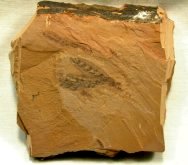Haikouella lanceolata
Phylum Chordata, unranked clade Craniata
Geological Time: Early Cambrian (~525 million years ago)
Size: 16-22 mm long
Fossil Site: Chengjiang Maotianshan Shales,: Quiongzhusi Section, Yu’anshan Member, Heilinpu Formation, Anning, Yunnan Province, China.
|
Haikouella fossils are found in association with Haikouichthys and Myllokunmingia that by consensus are considered to be the oldest known true craniates and probably the oldest fishes. Craniata
(meaning animals with a hard bone or cartilage skull, or more
simply, chordates
with heads) is a huge animal clade containing
lampreys and armored jawless fishes, armored fish, This fossil has three Haikouella measuring some 16 to 22 mm. Reference: Chen, J.-Y.; Huang, D.-Y.; Li, C.-W. (1999). "An early Cambrian craniate-like chordate". Nature 402 (6761): 518–522. Also
see: Chengjiang
Biota, Chengjiang
Fossils, Cambrian
Explosion |





